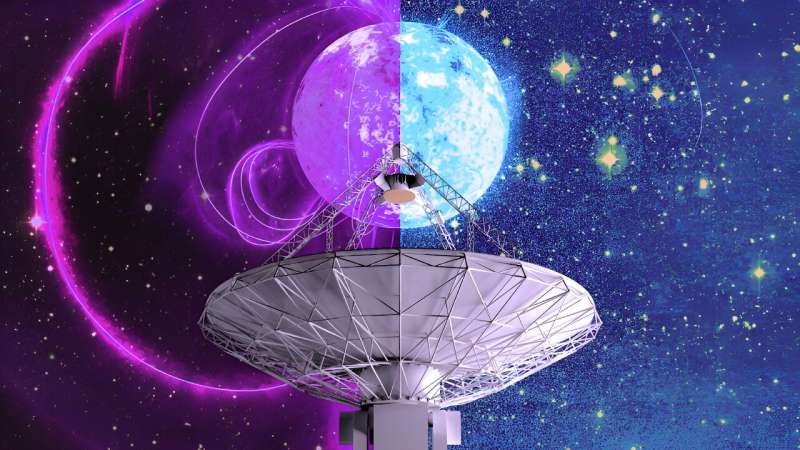
The ASKAP radio telescope detects polarized radio signals across the sky. Credit: ASKAP
When astronomers point our radio telescopes out into space, we sometimes detect sporadic bursts of radio waves coming from across the vast expanse of the universe. We call them “transient radios”: some explode only once, never to be seen again, and others turn on and off in predictable patterns.
We think most radio transients come from rotating neutron stars known as pulsars, which emit regular bursts of radio waves like cosmic seeds. Typically, these neutron stars spin at incredible speeds, taking only seconds or even fractions of a second to complete each rotation.
Recently, we discovered a radio transient that is unlike anything astronomers have seen before. Not only does it have a long cycle of almost an hour (the longest ever seen), but during several observations we saw it sometimes emit long, bright flashes, sometimes quick, weak pulses – and sometimes nothing at all .
We cannot explain what is happening here. It is most likely a very unusual neutron star, but we cannot rule out other possibilities. Our research is published in Astronomy of Nature.
A lucky find
Meet ASKAP J1935+2148 (the numbers in the name indicate its location in the sky). This periodic radio transient was discovered using CSIRO’s ASKAP radio telescope at the Wajarri Yamaji site in Western Australia.
The telescope has a very wide field of view, which means it can observe large volumes of the universe very quickly. This makes it very suitable for discovering new and exotic phenomena.
Using ASKAP, we were simultaneously monitoring a gamma-ray source and looking for pulses from a fast radio burst when we noticed ASKAP J1935+2148 slowly flashing in the data. The signal was thrown out because it consisted of “circularly polarized” radio waves, meaning that the direction of the waves is locked around as the signal travels through space.
Our eyes cannot distinguish between circularly polarized light and ordinary unpolarized light. However, ASKAP works like a pair of Polaroid sunglasses, filtering out glare from thousands of common sources.
After the initial discovery, we carried out further observations over several months using ASKAP and also the more sensitive MeerKAT radio telescope in South Africa.
Slowest radio transient ever found
ASKAP J1935+2148 belongs to a relatively new class of long-period radio transients. Only two others have ever been found, and the 53.8 minute period of ASKAP J1935+2148 is by far the longest.
However, the extremely long period is only the beginning. We have seen ASKAP J1935+2148 in three different states or modes.
In the first state, we see bright, linear (rather than circular) polarized pulses lasting from 10 to 50 seconds. In the second state, there are much weaker, circularly polarized pulses lasting only about 370 milliseconds. The third state is a calm or extinguished state, with no impulses at all.
These different modes, and switching between them, can result from a combination of complex magnetic fields and plasma flows from the source itself with strong magnetic fields in the surrounding space.
Similar patterns have been seen in neutron stars, but our current understanding of neutron stars suggests that they should not be able to have such a long period.
Neutron stars and white dwarfs
The origin of such a long-period signal remains a deep mystery, with a slow-spinning neutron star the prime suspect. However, we can’t rule out the possibility that the object is a white dwarf—a burned-out Earth-sized star that has run out of fuel.
White dwarfs often have slow rotation periods, but we don’t know of any way to produce the radio signals we’re seeing here. Furthermore, there are no other highly magnetic white dwarfs nearby, which makes the neutron star explanation more plausible.
One explanation could be that the object is part of a binary system in which a neutron star or white dwarf orbits another invisible star.
This object could prompt us to reexamine our decades-old understanding of neutron stars, or white dwarfs, particularly how they emit radio waves and what their populations are like within our galaxy. Further research is needed to confirm what the object is, but either scenario would provide valuable insights into the physics of these extreme objects.
The search continues
We do not know how long ASKAP J1935+2148 has been emitting radio signals, as radio astronomy surveys do not usually look for objects with such long periods. Furthermore, radio emissions from this source are only detected for only 0.01% to 1.5% of its rotation period, depending on its emission state.
So we were quite lucky that ASKAP J1935+2148 caught our eye. It is very likely that there are many other objects like it elsewhere in our galaxy, waiting to be discovered.
Provided by The Conversation
This article is republished from The Conversation under a Creative Commons license. Read the original article.![]()
citation: A strange intermittent radio signal from space has puzzled astronomers (2024, June 5) Retrieved June 6, 2024 from https://phys.org/news/2024-06-strange-intermittent-radio-space-astronomers. html
This document is subject to copyright. Except for any fair agreement for study or private research purposes, no part may be reproduced without written permission. The content is provided for informational purposes only.